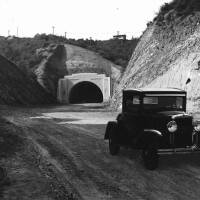The 5, the 101, the 405: Why Southern Californians Love Saying 'the' Before Freeway Numbers

Southern Californians have a distinctive – "Saturday Night Live's" Fred Armisen and Kristen Wiig might say funny – way of giving directions. To get from Santa Monica to Hollywood, take the 10 to the 110 to the 101. Burbank to San Diego? The 134 to the 5. And, if you can, always avoid the 405.
Why the definite articles? After all, a resident of the Bay Area enjoys coastal drives along "101" or takes "80 east" to Sacramento. Most of North America, in fact, omits the "the" before route numbers.
The answer begins with the region's early embrace of the freeway. Long before the National Interstate and Defense Highways Act of 1956 gave most U.S. cities their first freeways, Los Angeles had built several. These weren't simply extensions of federal interstate highways through the city; they were local routes, engineered to carry local traffic and (partly) paid for by local funds. It only made sense that, as they opened one by one, they'd get local names, ones that succinctly denoted their route or destination. The freeway through the Cahuenga Pass thus became the Cahuenga Pass Freeway, and Angelenos knew the freeway to San Bernardino as the San Bernardino Freeway.
State highway officials did affix route numbers to these freeways. But clarity dictated that Southern Californians continue to use their descriptive names. In their early years, most Los Angeles-area freeways bore signs for multiple numbered highway routes. The Pasadena Freeway, for example, was Route 6, 66, and 99, all at once. The Harbor Freeway carried both Route 6 and Route 11. The Hollywood, Route 66 and 101. Who wouldn't prefer the simplicity of a name over a confusing array of numbers?


Soon a shorthand emerged for describing a route through the city. Joan Didion captured this Southern California vernacular in "Play It As It Lays" (1970), in which Maria "drove the San Diego to the Harbor, the Harbor up to the Hollywood, the Hollywood to the Golden State, the Santa Monica, the Santa Ana, the Pasadena, the Ventura."
How, then, did that morph into "the 405 to the 110, the 110 up to the 101, the 101 to the 5, the 10, the 5, the 110, the 134"?
Two developments convinced Southern Californians to refer to freeways by number rather than name. In 1964, the state simplified its highway numbering system, ensuring that, with few exceptions, each freeway would bear only one route number. Around the same time, a flurry of new construction added unfamiliar freeway names to the region's road maps. Drivers found it easier to learn new numbers like the 605 or the 91 rather than new names like the San Gabriel River Freeway or the Redondo Beach Freeway.
Although the transition was gradual – numbers only eclipsed names in common usage in the late 1970s, and Caltrans still included the old names in signage through the 1990s – Southern Californians eventually joined the rest of North America in referring to freeways by number. But when they did, they retained their old habit of prefixing a definite article, the, giving rise to a regional idiom that still confounds and amuses outsiders today.
See More – That Explains It: Answers to Things You've Always Wondered About L.A.

Further Reading and Research
- Geyer, Grant. "'The' Freeway in Southern California," American Speech 76.2 (2001): 221-224.
- Metro Transportation Library and Archive, Los Angeles Transit And Transportation Studies, 1911-1957.


